
 Released over a year ago in June of 2012, The Chaperone, by local Kansas author Laura Moriarty, is still sizzling hot among readers! Set in the summer of 1922, The Chaperone opens in Wichita, Kansas during prohibition. Budding actress Louise Brooks, known best for her rebellious behavior and black bob and bangs, is only 15 years old and setting off for a summer of studying dance in New York City. To protect the integrity of her daughter, Ms. Brooks’ mother, Myra Rude, employs 36-year old Cora Carlisle to look after and chaperone her daughter while in the big city. Told from Cora’s perspective, the book is more than a fictionalized rendition of Louise Brooks’ entrance to stardom. A good portion of the story is dedicated to Cora’s hunt to find her birth parents while in New York. As one of the 200,000 children sent away on the orphan trains to the Midwest, Cora has never known her birth parents. Finding herself back in Manhattan near the orphanage where she spent the first years of her life, Cora makes it her mission to find the identities of her birth parents. The Chaperone has an interesting added dichotomy in that Cora’s role with Louise is that of Chaperone, protector of sexual propriety, yet Cora faces multiple personal moral dilemmas within her own marriage. As Cora confronts these challenges, she finds herself learning from her young ward, who may be more experienced in such topics than previously believed. While many may argue that the third part of the book would be better suited as an epilogue, I believe it is this portion of the book that transforms it from being just another historical fiction novel into a unique and risqué best-seller. Moriarty, as stated during her May 28th book club visit at the Corinth Neighborhood Library, was adamant with her publisher that this be left as a third part, rather than a tacked on follow-up. It is this section of the book where we see the true depth in not only Cora’s character, but also in Louise’s. However, if the reader is only interested in a casual story about Louise Brooks’ summer adventures in NYC in 1922, then I would recommend stopping after the first two parts. The book hits on many controversial topics, especially when considered within the time period in which it is set. Homosexuality, pedophilia, under aged—and at the time, illegal—drinking, closed adoptions, abortions, and much more. The historical accuracy of The Chaperone is admirable and captures the true sentiment of the time, without villainizing any of the characters. Those who enjoyed this book might also enjoy The Rules of Civility by Amor Towles, The Paris Wife by Paula McLain, or The Amazing Adventures of Kavalier and Clay by Michael Chabon.
Released over a year ago in June of 2012, The Chaperone, by local Kansas author Laura Moriarty, is still sizzling hot among readers! Set in the summer of 1922, The Chaperone opens in Wichita, Kansas during prohibition. Budding actress Louise Brooks, known best for her rebellious behavior and black bob and bangs, is only 15 years old and setting off for a summer of studying dance in New York City. To protect the integrity of her daughter, Ms. Brooks’ mother, Myra Rude, employs 36-year old Cora Carlisle to look after and chaperone her daughter while in the big city. Told from Cora’s perspective, the book is more than a fictionalized rendition of Louise Brooks’ entrance to stardom. A good portion of the story is dedicated to Cora’s hunt to find her birth parents while in New York. As one of the 200,000 children sent away on the orphan trains to the Midwest, Cora has never known her birth parents. Finding herself back in Manhattan near the orphanage where she spent the first years of her life, Cora makes it her mission to find the identities of her birth parents. The Chaperone has an interesting added dichotomy in that Cora’s role with Louise is that of Chaperone, protector of sexual propriety, yet Cora faces multiple personal moral dilemmas within her own marriage. As Cora confronts these challenges, she finds herself learning from her young ward, who may be more experienced in such topics than previously believed. While many may argue that the third part of the book would be better suited as an epilogue, I believe it is this portion of the book that transforms it from being just another historical fiction novel into a unique and risqué best-seller. Moriarty, as stated during her May 28th book club visit at the Corinth Neighborhood Library, was adamant with her publisher that this be left as a third part, rather than a tacked on follow-up. It is this section of the book where we see the true depth in not only Cora’s character, but also in Louise’s. However, if the reader is only interested in a casual story about Louise Brooks’ summer adventures in NYC in 1922, then I would recommend stopping after the first two parts. The book hits on many controversial topics, especially when considered within the time period in which it is set. Homosexuality, pedophilia, under aged—and at the time, illegal—drinking, closed adoptions, abortions, and much more. The historical accuracy of The Chaperone is admirable and captures the true sentiment of the time, without villainizing any of the characters. Those who enjoyed this book might also enjoy The Rules of Civility by Amor Towles, The Paris Wife by Paula McLain, or The Amazing Adventures of Kavalier and Clay by Michael Chabon.
